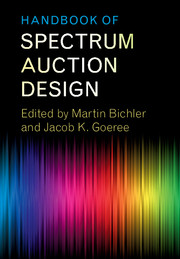Book contents
- Frontmatter
- Contents
- List of Contributors
- Preface
- List of Papers
- Part I The Simultaneous Multiple-Round Auction
- Part II The Combinatorial Clock Auction Designs
- Part III Alternative Auction Designs
- Part IV Experimental Comparisons of Auction Designs
- Part V The Bidders’ Perspective
- Part VI Secondary Markets and Exchanges
- 36 Spectrum Markets: Motivation, Challenges, and Implications
- 37 Designing the US Incentive Auction
- 38 Solving the Station Repacking Problem
- 39 ICE: An Expressive Iterative Combinatorial Exchange
- 40 ACE: A Combinatorial Market Mechanism
- Outlook
- References
36 - Spectrum Markets: Motivation, Challenges, and Implications
from Part VI - Secondary Markets and Exchanges
Published online by Cambridge University Press: 26 October 2017
- Frontmatter
- Contents
- List of Contributors
- Preface
- List of Papers
- Part I The Simultaneous Multiple-Round Auction
- Part II The Combinatorial Clock Auction Designs
- Part III Alternative Auction Designs
- Part IV Experimental Comparisons of Auction Designs
- Part V The Bidders’ Perspective
- Part VI Secondary Markets and Exchanges
- 36 Spectrum Markets: Motivation, Challenges, and Implications
- 37 Designing the US Incentive Auction
- 38 Solving the Station Repacking Problem
- 39 ICE: An Expressive Iterative Combinatorial Exchange
- 40 ACE: A Combinatorial Market Mechanism
- Outlook
- References
Summary
Introduction
The continued growth of wireless networks and services depends on the availability of adequate spectrum resources. Accelerating demand for those resources, due to the popularity of portable data-intensive wireless devices, are testing the limits of current commercial wireless networks, underscoring the need for changes in current spectrum allocations. This has prompted the Federal Communications Commission (FCC) in the United States to consider ways to increase the supply of spectrum allocated to broadband access and to introduce techniques for improving the utilization of existing allocations [1, Ch. 5].
Spectrum allocations generally fall into one of two categories: a licensed allocation gives exclusive use rights to the licensee, whereas an unlicensed allocation corresponds to the commons model in which the band can be shared by different applications and service providers [2]. Licensed spectrum typically carries restrictions on how it can be used, and is generally not transferable. Although these restrictions have been alleviated to some extent by the introduction of secondary spectrum markets [3], existing rules still inhibit the reallocation of spectrum to more efficient uses.
In contrast to the current “command and control” method for licensing spectrum, a spectrum market is based on a notion of spectrum property rights, which can be traded among buyers and sellers. The potential benefits of spectrum markets for increasing the efficiency of spectrum allocations is widely acknowledged. Thus far related discussions have focused on secondary markets, which allow service providers with licensed spectrum to lease their spectrum to other service providers. Transactions must be filed with the FCC for approval (which are automatic in some scenarios), introducing delays that increase transaction costs [3].
Here we reconsider the spectrum allocation problem without existing regulatory constraints. We start by providing general motivations for introducing spectrum markets. That is, a basic policy choice is whether to define and enforce spectrum property rights. From a social welfare point of view, this choice ultimately depends on whether spectrum is scarce, that is, if demand for it exceeds supply when it is free.
- Type
- Chapter
- Information
- Handbook of Spectrum Auction Design , pp. 785 - 802Publisher: Cambridge University PressPrint publication year: 2017
References
- 1
- Cited by



